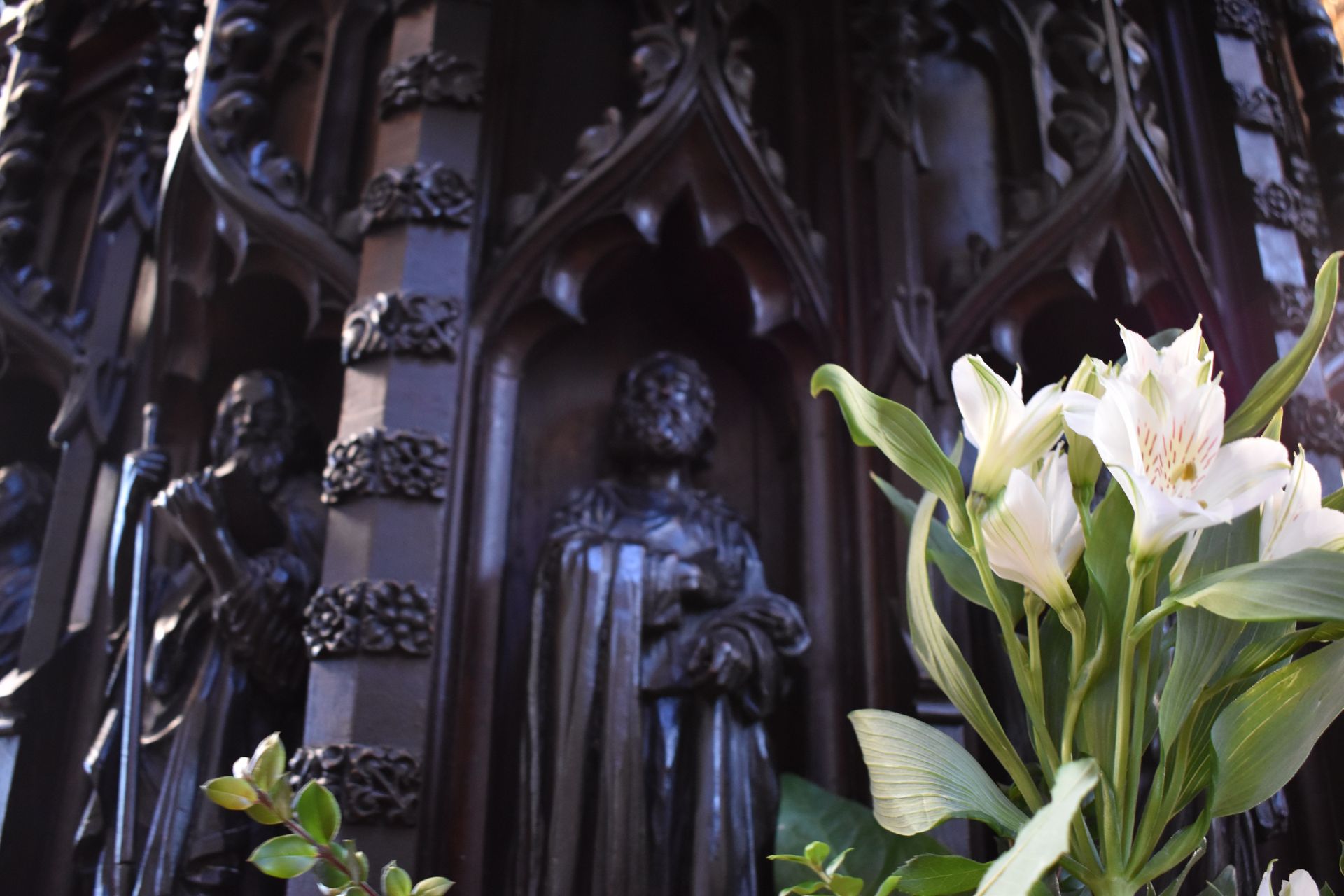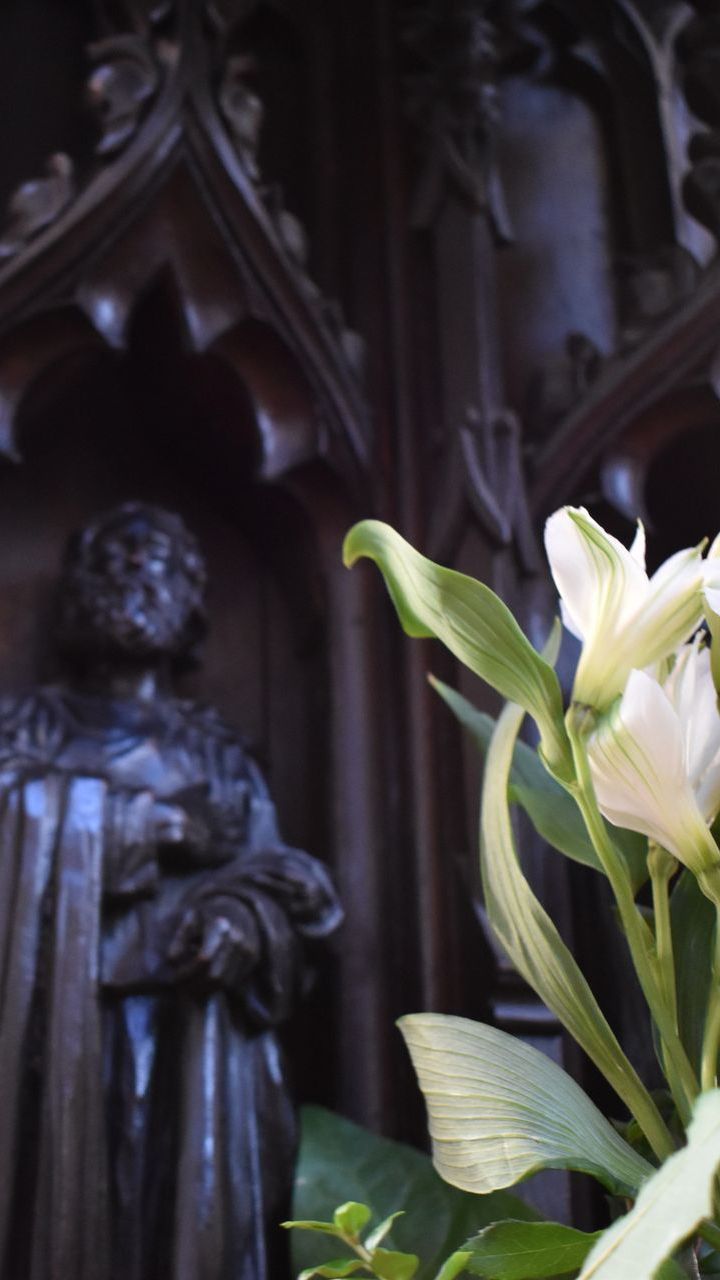The Heart of the Matter
The crossing offers superb 360° views, north and south across the transepts, west down the length of the nave and east to the chancel and altar. To the south of the crossing is the tomb of Admiral William Penn whose armour and pennants are displayed at the west end of the nave on the internal south wall of the tower.
Carved wooden pulpit
The pulpit was carved in 1856 by William Bennett, from Portishead, who also carved the fine oak pews in the nave. He was a Quaker and it is believed that he used his fellow Quakers as models for the carvings of the Apostles on the pulpit.
C17th brass eagle lectern
The brass eagle lectern dates from 1638 and was given to the church by parishioner and churchwarden James Wathen, who was a brass pinmaker by trade.
Tomb of Admiral Sir William Penn
Admiral Sir William Penn's tomb can be found in the floor between the crossing and south transept. His armour and pennants are displayed on the wall at the west end of the nave.
Penn's Biography
Admiral Sir William Penn was born in the parish of St Thomas the Martyr, Bristol (the neighbouring parish to St Mary Redcliffe) in 1621. He was the son of the sea captain Giles Penn and his wife Joan Penn (maiden name Gilbert) who married at St Mary Redcliffe. William Penn was appointed as a captain in the Royal Navy in 1643 at the age of 22. On 6 June in the same year he married a Dutch widow, Margaret Van der Schure, at St-Martin-within-Ludgate, 40 Ludgate Hill, London (near Margaret's family home in The Strand). The officiant at the wedding is recorded in the church's records and in a certificate at the City of London Guildhall as: "Mr Dyke, Lecturer" The title 'Lecturer' indicates a holder of a stipend for preaching - ie a Puritan officiated at the wedding, rather than the Anglican clergyman appointed to serve in that church. The newly weds lived in Tower Gardens, in two rooms of navy quarters. After Penn was promoted in 1644 they moved into a house owned by King Charles II and it was in this house that their son William was born on 14 October 1644.
Penn's naval career took him away from home for long periods. However when he did have time back in London it seems he enjoyed life to the full. Samuel Pepys, diarist and a colleague of Penn senior when Penn moved to a role at the Admiralty, records that Penn senior indulged, "drinking the susceptible into a stupor, singing bawd songs and supping at midnight oft bread-and-butter on the roof." Pepys also described Admiral Penn as "a very merry fellow" and records Penn's wife, Margaret, in a similar light, her pranks apparently included,"flinging Pepys on a bed at a party and heaping female guests upon him."
The Penn family's personal wealth grew, presumably assisted by Penn's ever more successful naval career and also the income from his wife's land holdings in Ireland, which Penn successfully petitioned Oliver Cromwell to restore to her (this was done by an Order in Council dated 1 September 1654.
When the Great Plague hit London in 1655, the Penns moved to safer lodgings in Woolwich. By this time Penn was working at the Navy Board. The family acquired a country house at Walthamstow, where their close friend Sir William Batten, a Bristolian who was a Surveyor of the Navy, also had a home. Penn and Batten often entertained Samuel Pepys.
In 1669 Penn resigned from the Navy Board and the family moved permanently to the countryside, living at Wanstead. Here. Admiral Sir William Penn died on 16 September 1670.
His will stated that his body should be buried in St Mary Redcliffe Church, "as near unto the body of my deare Mother deceased whose body lyes there interned as the same conveniently may And my will is that there shall be erected in the said church as near unto the place where my body shall bee buried as the same can be contrived A Hansome and Decent Tombe to remain as a monument as well for my said Mother as for my Self."
Penn's naval career
William Penn was appointed as a captain in the Royal Navy in 1643 at the age of 22. From 1642 - 1651 during the English Civil Wars Penn served in the Parliamentarian Navy as senior commander. When he was not at sea during this period, he lived with his family in London. During the conflict his home city of Bristol was attacked by Royalist forces led by Prince Rupert (the German nephew of Charles I). Rupert's forces robbed, sacked and burned homes, turning out many from their houses.
Penn was appointed Rear Admiral of the Irish Seas in 1647.
He was arrested in 1648 on suspicion of corresponding with King Charles I but was soon released.
Penn fought in the first Anglo-Dutch War 1652 - 1654.
In 1654 he secretly offered the fleet to the exiled King Charles II.
He then commanded the expedition sent by Oliver Cromwell to the West Indies which, in May 1655, captured Jamaica from the Spanish. This enabled the island to become the centre of English slave trading and sugar production. Penn became its first governor and this added to his personal wealth.
However, at the Siege of Santo Domingo of 1655, during a major battle fought between April 23 to April 30, 1655 at the Spanish Colony of Santo Domingo (Hispaniola), a force of 2,400 Spanish troops, led by Governor Don Bernardino Menses and Bracamonte, Count of Peñalba, defeated a force of 13,120 troops and 34 ships of the English Commonwealth Navy led by Admiral Sir William Penn. On his return to Britain Penn was briefly imprisoned, for reasons that are not clear.
He retired to the family's restored Irish estates for a while, engaging in secret correspondence with the Royalists.
Post-restoration
After Cromwell's death and the Restoration of the Crown in 1660, Penn offered the fleet to King Charles II and gained the King's favour, knighthood and appointment as a commissioner for the Navy (an extraordinary turn of events, given that he had been one of the most senior Parliamentarian naval commanders).
Penn's role as a commissioner for the Navy led him to work with Samuel Pepys at the Admiralty, where Pepys was Penn's deputy. Apparently they argued a good deal - but together they reformed the structure and administration of the navy, laying the foundations for Britain's later dominance of the seas and arguably of the British Empire.
Penn loaned most of his personal fortune to help fund the King's ambitious naval building programme.
In the Second Dutch War (1665 - 1667) Penn served as Captain of the Fleet with the Duke of York (the future King James II). Penn wrote the code of naval tactics that was the basis of the "Duke of York's Sailing and Fighting Instructions" which was for a long time the orthodox tactical guide for the Royal Navy.
Pennsylvania
Penn's son, William Penn the younger, was a leading and, according to contemporary commentators, a troublesome' Quaker. After his father's death in 1670, he asked the monarch to repay the debt but the cash strapped King could not do so. So he offered Penn the younger land in America to redeem the debts. Penn the younger wanted to name this territory "Sylvania" but the King insisted that should be prefaced "Penn" in honour of the Admiral. Thus the state of Pennsylvania came into being. Its arms still incorporate those of the man whose name it bears.
Embroidered altar frontal by Elizabeth Fry (1870-1952)
Mrs Janet Elizabeth Fry made more than two hundred hand embroidered church pieces over the course of just twenty years, of which over a hundred were vestments with accessories.
There were lovely altar frontals and other items for churches, chapels, naval establishments and ships, plus many beautiful items for clergy, bishops and archbishops both near and far.
She began her extraordinary work at the age of 55, when the local village priest had no money to buy a badly needed new vestment. In her words "Then it struck my mind to make a complete garment for him myself. And after that I could not stop making them. Again and again I received new requests to help ." and responded to every one - beautifully!
Mrs Fry was the wife of Roderick Fry, chairman of the famous local chocolate making company. She took up embroidery as a hobby in 1927. Mrs Fry was a good friend of Dr Geoffrey Fisher, Archbishop of Canterbury, for whom she made a special cope for the 1947 Royal Wedding. By this time she had already made over 130 altar frontals, 9 copes, 280 sets of vestments, 380 stoles and equipped the chapels of 33 naval vessels, as well as making the vestments for three archbishops for their enthronements.
Both St Mary Redcliffe and Bristol Cathedral have fine collections of vestments and other items embroidered by Mrs Fry. All are still in regular use, save those currently too frail and awaiting restoration. Both churches have restoration programmes which they are gradually working through under the guidance of specialist conservators.
The mystery monuments
In his 1813 monograph on the church, John Britton refers to two monuments that have since entirely disappeared: those of Everard Le Frensshe - who founded a chantry in the church in 1350 - and Thomas Young
EVERARDUS LE FRENSSHE , or LE FRAUNCEYS . Near the centre of the cross aile stands a plain altar tomb , supporting the recumbent figure of a person in magisterial robes , The inscription , which is now nearly erazed , was as follows : " Hic jacet Everardus le French , qui in hac ecclesia duas fundavit cantarias et duas alias in ecclesia St. Nicolai , et fuit ter maior hujus villae , cujus animae propitietur Deus . Amen . M.CCC.L. " Everardus le Fraunceys was mayor of Bristol in the years 1333 , 1337 , and 1339 , and member for that city in three different parliaments held at Westminster in the twenty - first and twenty - second years of the reign of Edward the Third.— Barrett , Hist . Bristol , p . 151 , 675 .
THOMAS YOUNG . On a marble monument in the cross aile, is this inscription : - " Hic inferius sub lapide marmorea sepelitur corpus Thomæ Young armigeri , nuper de villa Bristol , ac filii ac haeredis Thomae Young unius justiciorum in communi Banco , et Jocosae uxoris ejus qui quidem Thomas obiit 15 Maii , A. D. 1506 , quorum animabus propitietur Deus , Amen . " Thomas Young was several times representative for Bristol during the reign of Henry the Sixth


